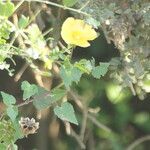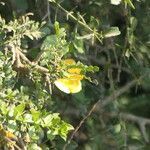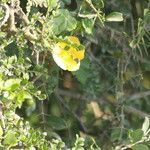Leaf-lamina 2–7 (10) × 1–5 (7) cm., usually triangular-cordate or ovate-cordate, sometimes somewhat 3-lobed with blunt lobes on either side of the lamina near the middle, apex acuminate, margin ± dentate, crenate or serrate, dark green, brownish-green when dry, dark grey-green or olive-green on upper surface, paler greyish-to light-glaucous-green on the lower surface, venation of lower surface distinct, fine but prominent; petiole lender, terete, with the long patent hairs often only at the very apex, that of lower leaves often longer, that of upper leaves often shorter than the lamina.
Shrubby perennial 0·5–1·5 (2) m. tall, usually with only one or a few main stems, with a very dense short soft velvety indumentum and additional sparse long white patent hairs (rarely completely absent), less often long-pilose; stems slender, terete or slightly angular when young, tough or wiry, olive-drab to purplish-brown, woody when older, and ultimately covered with a grey to dark brown thin bark densely marked with short longitudinal shallow grooves.
Perennial shrub, 0.5-1.5(-2.0) m high; young stems without many, patent, simple hairs. Leaves ovate to triangular, 20-70 x 10-50 mm, base cordate. Flowers: petals ± 10 mm long, yellow or orange-yellow; Jul., Nov.-Apr. Fruit with mericarps subrectangular in outline, much compressed, nearly glabrous and papery when mature; upper dorsal angle acute, ventral tooth usually conspicuously curved at tip, > 14 x 8 mm, apex of mericarps awned to obtusely angled.
Mericarps 8–15, often 9–11, 10–14 × 7–9 mm., much compressed, papery, subrectangular in outline, with rounded base and nearly horizontal truncate apical edge produced at the dorsal apical angle into a point or subulate awn up to 2 mm. long, the ventral tooth often somewhat upturned at the apex, 3–8 (often 4 or 5)-seeded.
Perennial shrub, 0.5-1.5(-2.0) m high. Mericarps subrectangular in outline, much compressed, nearly glabrous and papery when mature; upper dorsal angle acute; ventral tooth usually conspicuously upcurved at tip. Flowers yellow or orange-yellow.
Calyx 8–10 mm. long and 6 mm. in diam. at the throat, greyish to olive-drab, divided to or beyond the middle; lobes 4–10 mm. long, ovate-elliptic, ovate-lanceolate to lanceolate-triangular, attenuate-acuminate into an acute tip, median-veined.
Flowers yellow or orange-yellow, solitary in axils on developed branches; pedicels c. 6 cm. (in fruit 10 cm.) long, slender, terete, articulated in the upper 6–12 mm.
Velvety shrubby perennial to 2 m. Leaves heart-shaped, obscurely lobed, toothed or crenate, pale beneath. Flowers on long axillary pedicels, pink to yellow or orange.
Fruit 12–15 × 20 mm., subcylindric-semiglobose, truncate, densely and finely stellate-pubescent.
Staminal tube glabrous except at line of fusion with the petals.
Seeds c. 2 × 2 mm., finely verruculose-rugulose, glabrous.
Petals c. 10 mm. long, glabrous except at the base.



